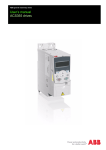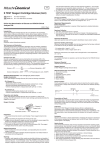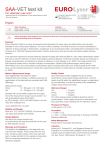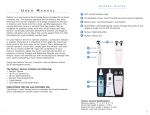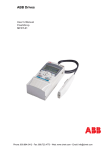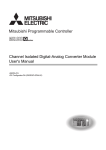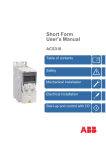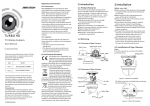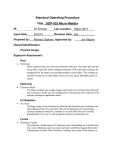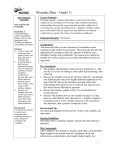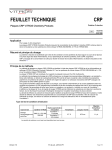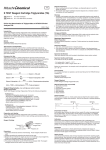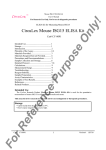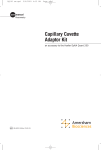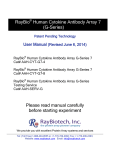Download E40 CRP - Sekisui Diagnostics
Transcript
S TEST Reagent Cartridge C-Reactive Protein (CRP ( 96320-10 96320-100 10 S TEST Cartridges 10 x 10 S TEST Boxes (100 Tests) Kit for the determination of C-Reactive Protein on HITACHI Clinical Analyzer E40 2012-12 Rev.0 Storage and Stability The S TEST Reagent Cartridge C-Reactive Protein (CRP) is stable until the expiration date shown on the box labels when stored in the refrigerator at 2 – 8 °C. Specimen Requirements Patient Preparation No special patient preparation is required. Collect specimen by standard laboratory technique. Specimen Collection 1. Use clear, unhemolyzed serum or plasma collected by venipuncture. 2. Care should be taken to preserve the chemical integrity of the blood specimen from the time it is collected by venipuncture until the time it is assayed (see SPECIMEN HANDLING AND STORAGE). Specimen Identification Label each specimen tube with the patient's identification (name and/or number). Intended Use The S TEST Reagent Cartridge C-Reactive Protein (CRP) is intended for the quantitative determination of C-Reactive Protein concentration in serum, lithium heparin plasma, K3 EDTA plasma and sodium citrate plasma using the HITACHI Clinical Analyzer E40. The S TEST Reagent Cartridge C-Reactive Protein (CRP) is intended for use in clinical laboratories or physician office laboratories. CRP measurements aid in the evaluation of injury to body tissues, and infection and inflammatory disorders. For in vitro diagnostic use only. Specimen Handling and Storage If not tested on the day of collection, store as follows: Method Latex agglutination turbidimetric immunoassay Test Procedure For complete information on operation, see the User Manual for the HITACHI Clinical Analyzer E40. Test Summary and Explanation CRP is an abnormal protein produced as a result of various types of inflammation or biological reactions against tissue necrosis, and is known to cause a precipitation reaction with C polysaccharides in the presence of calcium ions. Measurement of CRP is considered a useful tool to examine whether there is an inflammatory focus in the body. Principle of the Test CRP in samples causes an antigen-antibody reaction with latex sensitizes with Goat anti-human C-reactive protein antibody to induce agglutination. The concentration of CRP can be determined by measuring this agglutination as the amount of change in absorbance. CRP + Latex coated with goat anti-human C-reactive protein antibody Agglutination due to antigen-antibody reaction Reagent Requirements- one cartridge per patient sample Reagent Composition The S TEST Reagent Cartridge C-Reactive Protein (CRP) has the following composition: CRP Reagent (1): • 2-Amino-2-hydroxymethyl-1,3-propanediol buffer (pH 7.4) 0.2 mol/L CRP Reagent (2): • Latex coated with goat anti-human C-reactive protein antibody 17.5 % Preparation and Labeling The S TEST Reagent Cartridge C-Reactive Protein (CRP) is provided in a ready-touse cartridge. The 2D code label on the front of each cartridge automatically identifies the reagent to the system. Reagent Cartridge Reagent (2) 2D code Photometric cuvette Reagent (1) Reagent cells Reaction cell Precautions 1. This product should be stored to avoid freezing. Frozen reagent should not be used. 2. Reagent exceeding the expiration date should not be used. 3. Reagent kits are intended for single use only. Do not attempt to reuse reagent kits. Discard any damaged reagent kits or kits that arrive opened. 4. Avoid direct sunlight during storage and measurement. 5. This product is intended for use on HITACHI Clinical Analyzer E40. The reagent cartridges should not be used for any other purposes. Disposal Precautions 1. When handling blood and used cartridges, use disposable gloves to avoid the danger of infection. 2. The samples and reagent cartridges should be disposed of as medical wastes in accordance with local regulations. Warnings 1. Samples, used reagents and other waste are potentially infectious and capable of transmitting human immunodeficiency virus (HIV), hepatitis B virus (HBV) and other infectious diseases. Avoid immediate contact. The handling and disposal of patient samples, reagents and liquid waste must be performed according to local, national, and international laboratory safety and waste disposal regulations. This includes wearing gloves and appropriate splash protection, etc. If these substances come in contact with skin, rinse with ample water, disinfect, and consult a physician. 2. CRP Reagent (1) and (2) contain sodium azide, an antiseptic which may be irritating to eyes, skin and mucous membranes. Sodium azide may react with copper and lead plumbing to produce explosive metal azide; flush with copious amounts of water if disposing down the drain. • For testing within 1 week: 2 – 10 °C • For testing after 1 week or longer: below -20 °C Before the measurement, the sample must be brought back to room temperature (15 – 30 °C). Equipment Required HITACHI Clinical Analyzer E40 Reagent Required S TEST Reagent Cartridge C-Reactive Protein (CRP) Material Required (but not provided) 1. Two levels of controls 2. Sample cups 3. Disposable transfer pipettes 4. Washing water 5. Alkali detergent 6. Waste container Assay Procedure Prior to performing each run, check system status to determine the need to replace washing water or empty waste container. See the User Manual for detailed operating instructions. Measurement (570 / 800 nm) Reagent(1) / Sample 180 μL / 6 μL 0 Reagent(2) 180 μL 7.5 Conc. Calculation 8.5 11.5 (min) Wavelength (main/sub) Presentation of Result Each patient report includes the data and time, sample ID number (as programmed), the test abbreviation, the test results, normal ranges and result flags. For detailed explanations on flags and error messages, refer to the User Manual for the HITACHI Clinical Analyzer E40. Calibration Each lot of S TEST Reagent Cartridge C-Reactive Protein (CRP) is calibrated by the manufacturer prior to shipment using material traceable to IRMM Standard Reference Material ERM-DA472. The 2D code printed on each cartridge provides the analyzer with lot-specific calibration data. Calculation CRP concentration is directly determined by multiplying the change in absorbance of the unknown samples by the calibrator factor on the 2D code. Patient and control results appear on the display. Quality Control Users should follow federal, state and local regulatory requirements regarding quality control practices. See instrument manual for procedures on how to run controls. Good laboratory practice includes the use of at least two levels of control material to ensure the test performance. The frequency and limits of QC testing should be determined according to individual laboratory standard QC procedures. Controls should be run at least once every 30 days and: 1.When test results do not match patient symptoms or clinical findings. 2.When using a new lot or shipment of reagents. 3.When laboratory environmental conditions have significantly changed. 4.When training or retraining of personnel occurs. 5.After specific maintenance on trouble shooting steps described in the User Manual for the HITACHI Clinical Analyzer E40. Reading and Reporting Results Expected Value • Reportable range: 1 - 150 mg/L • Reference range: Less than 10 mg/L 1 • It is recommended that each laboratory determine the expected values for its particular population. Interpretation of Results Non-specific reaction or interference may occur in immunological tests. There may be reactions with non-target substances or interfering reactions. If measured results seem unreliable, repeat the measurement (if necessary after dilution) or try another analytical measurement. Handling Critical Values If the result of a sample exceeds the measurement range, dilute the sample with physiological saline solution, and repeat the measurement. Samples beyond the measurement range will trigger the result of “>150 mg/L” or “*Limt*”. Samples below the measurement range will trigger the result “<1mg/L”. Performance Characteristics Detection limit (per CLSI EP17-A) The analytical detection limit was determined to be 0.7 mg/L. The quantitation limit was determined to be 1 mg/L. Reportable range 1 mg/L to 150 mg/L Interference (per CLSI EP7-A2) The data demonstrated that the CRP test system was not affected by high levels of the following substances at the levels noted. Routine Maintenance and Troubleshooting For complete information on operation, see the User Manual for the HITACHI Clinical Analyzer E40. Hemoglobin: no interference up to 1000 mg/dL Unconjugated bilirubin: no interference up to 50 mg/dL Lipemia: no interference up to 2000 mg/dL Ascorbic acid: no interference up to 50 mg/dL Technical Support/ Instrument Service 1. First contact your local distributor 2. Hitachi Chemical Co., Ltd. (Japan) Lack of interference was defined as recoveries between 90% and 110% of the neat value, and assay performance claims were established on the HITACHI Clinical Analyzer E40 by testing two serum pools containing approximately 12 mg/L and 80 mg/L CRP. The information presented is based on results from Hitachi studies and is current at the date of publication. Hitachi makes no representation about the completeness or accuracy of results generated by future studies. Precision (per CLSI EP5-A2) Three levels of serum samples were assayed 2 times per run, 2 runs per day, for total of 20 days. The precision was found to be: Level 1 2 3 n= 80 per level Mean (mg/L) 6 16 122 SD (mg/L) 0.4 1.2 3.4 Reference 1.Tietz, Tietz Fundamentals of Clinical Chemistry, 4th Edition, WB Saunders Company (1996) 2.CLSI Document EP5-A2, Evaluation of Precision Performance of Quantitative Measurement Methods, Approved Guideline 3.CLSI Document EP6-A, Evaluation of Linearity of Quantitative Measurement Procedures, Approved Guideline 4.CLSI Document EP7-A2, Interference Testing in Clinical Chemistry, Approved Guideline 5.CLSI Document EP17-A, Protocols for the Determination of Limits of Detection and Limits of Quantitation, Approved Guideline %CV 7.3 7.7 2.8 Precision (POL sites) Three levels of samples (A, B and C) were tested by three POL sites, six times a day for five days. The precision estimates are described below. Site # Sample Mean (mg/L) 1 A 4 2 A 4 3 A 4 1 B 50 2 B 52 3 B 54 1 C 96 2 C 92 3 C 94 n = 30 replicates per sample per site Within-run Precision SD (mg/L) %CV 0.2 5.9 0.4 12.4 0.4 11.6 1.9 3.8 1.5 2.8 1.2 2.3 5.1 5.3 4.0 4.3 3.5 3.7 Total Precision SD (mg/L) %CV 0.3 6.6 0.5 14.1 0.4 11.2 1.7 3.5 1.5 2.9 2.1 3.9 5.3 5.6 6.5 7.1 4.0 4.2 Patient Correlation (POL sites) A series of approximately 55 serum specimens with CRP values ranging from 1 to 130 mg/L were assayed on the HITACHI Clinical Analyzer E40 at three sites using the S TEST Reagent Cartridge C-Reactive Protein (CRP) (y) and a comparative method as the reference method (x). Linear regression analysis (least squares) yielded the following results: Site Range n Regression Equation # (mg/L) 1 56 1 to 122 y = 1.02x + 0.1 2 56 1 to 130 y = 1.06x - 0.2 3 55 1 to 125 y = 1.03x + 0.2 *95% Confidence Interval CI* Slope 0.99 1.00 to 1.04 0.99 1.05 to 1.08 0.99 1.01 to 1.05 “r” CI* Intercept -0.5 to 0.6 -0.6 to 0.2 -0.4 to 0.8 Patient Correlation (laboratory site) A series of 88 serum specimens with CRP values ranging from 1 to 125 mg/L were assayed on the HITACHI Clinical Analyze E40 using the S TEST Reagent Cartridge C-Reactive Protein (CRP) (y) and a comparative method as the reference method (x). Linear regression analysis (least squares) yielded the following results: Range Regression Equation (mg/L) 88 1 to 125 y = 0.99x + 0.1 *95% Confidence Interval n “r” 0.99 CI* Slope 0.96 to 1.01 CI* Intercept -0.6 to 0.9 Serum/Plasma Comparison Study A study was performed to validate the use of lithium heparin plasma, K3 EDTA plasma and sodium citrate plasma as alternatives to serum for the HITACHI Clinical Analyzer E40 with the S TEST Reagent Cartridge C-Reactive Protein (CRP). 45 matched serum/plasma samples that spanned the dynamic range were assayed in singleton and the results were compared using least squares linear regression (plasma = y-axis, each type). The performance characteristics were as follows. Lithium Heparin Plasma Slope (CI*) 1.00 (0.98 to 1.01) y-intercept (CI*) -0.1 (-0.8 to 0.5) r 0.99 n = 45 / Range (serum) = 1 to 123 mg/L *95% Confidence Interval K3 EDTA Plasma Na Citrate Plasma 0.99 (0.97 to 1.00) 0.1 (-0.6 to 0.7) 0.99 1.00 (0.99 to 1.01) -0.3 (-0.82 to 0.30) 0.99 80-7969-00-00 04/13 9-2, Marunouchi 1-chome, Chiyoda-ku, Tokyo 100-6606, Japan


